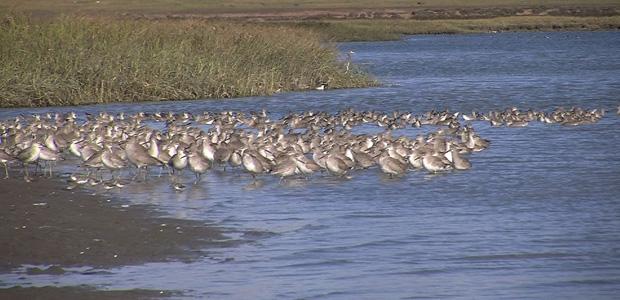Development Bust is Environmental Boon in Baja California
Hundreds of willets feed in the mud flats of San Quintín Bay, on Bajas Pacific coast. (Photo: Jill Replogle)
On the shore of the tiny Baja California fishing village of Santa Rosalillita there’s a marina, now abandoned and completely filled with sand. It’s just about all that’s left here of a dream of the Mexican government – a grand plan for a string of marinas along the coast of Baja and the Sea of Cortez, called the Escalera Naútica, or Nautical Staircase. But instead of bustling docks and a thriving new commercial center, the only things stirring here on a recent evening are dirt bikers, a few surfers, and the wind.
The failed Nautical Staircase has become the poster child for over-ambitious development dreams in Baja California.
“It was planned with the expectation that real estate was going to continue growing,” says Saúl Alarcón, executive director of the Mexican environmental group Terra Peninsular. “So they said, ‘well, let’s put some marinas in key places because we’re developing the entire coast. So eventually we’ll have thousands of people with yachts coming to Baja California.'”
During the pre-2008 real estate boom, many developers – and Americans in search of a plot of paradise – invested in this part of Mexico, with its miles and miles of then unspoiled, breathtaking coastline. The crash of 2008 put many of those projects on ice.
That was bad news for developers, but Serge Dedina, head of the US-Mexico conservation organization WiLDCOAST, says the economic downturn has been a boon for Baja’s natural resources.
“When the Baja boom was happening, it seemed like environmentalists were fighting all kinds of projects, from marina development projects, high-rise development projects and mega-resorts,” Dedina says.
Now, though, conservation groups have been able to turn the tables a bit. They’ve been buying up discounted coastal land from speculators, establishing conservation easements on private land, and working with the Mexican government to form new protected areas.
“We’ve been able to preserve some really world-class coastal biodiversity areas,” Dedina says, “areas where gray whales go, and where you see whale sharks. So that’s really exciting.”
Baja’s warm lagoons are crucial breeding and birthing areas for thousands of migrating gray whales. The area is also vital habitat for other animals.
Hundreds of willets feed in the mud flats of San Quintín Bay, on Baja’s Pacific coast. The bay is home to tens of thousands of shore birds and migratory waterfowl.
“It’s one of the last wetlands in North America with, I’d say 80 to 90 percent of the habitat is still in good shape,” Alarcón says.
The local government had hoped to turn part of the bay into a marina. A resort and golf course were also in the works. But now Alarcón’s organization is working with the Mexican government to turn nearly 300,000 acres here into a Biosphere Reserve.
It’s also bought up a nearby area of now-rare coastal sage scrub. And it’s helping local farmers establish low-impact agricultural practices. Alarcón says such efforts are protecting internationally important resources.
“You have environment, habitat, ecosystems that basically have disappeared in the rest of North America,” Alarcón says.
The real estate bust has given conservationists a new window of opportunity to save some of these. Of course the bust also means some dashed hopes for economic development.
Back in Santa Rosalillita, locals say the marina project would have brought welcome jobs and income.
Before it failed, it did bring some benefits, says local leader Javier Maclish–”a road and electricity.” But otherwise, Maclish says, the project has hurt his town. He says it caused beach erosion that has made life more difficult for local fishermen and has even forced some residents to abandon their homes.
Otherwise, quiet has returned to places like Santa Rosalillita. But it may be just a lull in the action, and conservationists like Saúl Alarcón may well still have to scramble to protect more land.
“Unfortunately, what happens in places like Baja California is people who are not from Baja California think that it’s empty land. And it has been always this case,” Alarcón says.
Activists say new development plans are again popping up along the peninsula. And Alarcón says it’s not just tourism and retirement homes anymore.
“Mining and energy projects. it is now the next rush,” Alarcón says.
